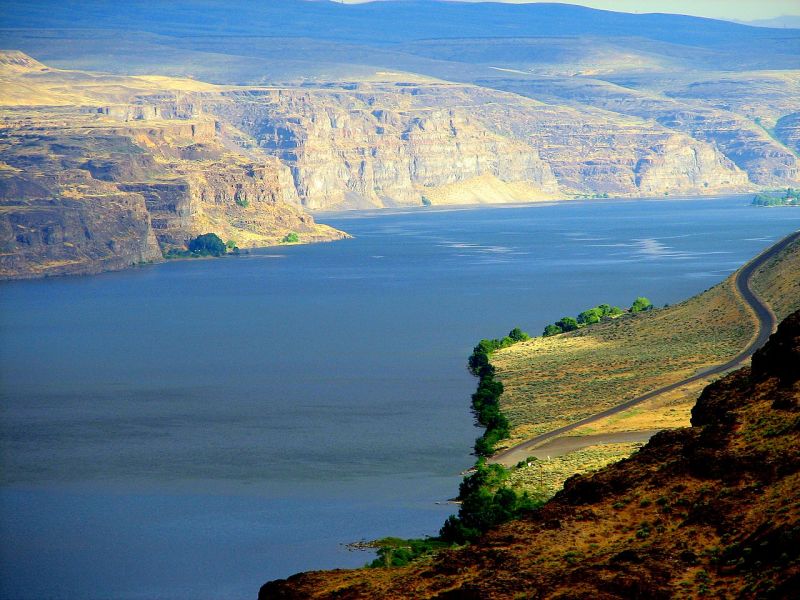Modeling Rivers Computationally
Published on by Water Network Research, Official research team of The Water Network in Academic
Xiaofeng Liu, assistant professor of civil and environmental engineering, works on simulating how materials dissolved or suspended in water flow through rivers. His models will be tested on the Columbia River in the Pacific Northwest.

Columbia River, source: Wikimedia Commons
What does a river researcher look like? The question may conjure images of people leaning over the sides of boats to gather water samples or standing in swirling currents with large nets to catch debris, chest-high waders almost entirely submerged.
You’re probably not picturing someone sitting at a computer, writing code and devising complex algorithms. Yet this is how Xiaofeng Liu, an assistant professor of civil and environmental engineering at Penn State and an Institute for CyberScience (ICS) co-hire, studies rivers: by modeling them computationally.
Liu is an expert in creating computer models of fluids, and he applies his skills to predicting how water — and materials suspended or dissolved in water — flow in rivers. This work has major implications for environmental studies.
“We’re currently working on a project to quantify how much carbon dioxide (CO2) rivers emit into the atmosphere,” said Liu. “This is critical for calculating our global carbon budget and understanding climate change.”
Rivers that Breathe
Recent research at Yale University, published in the journal Nature, has found that rivers contribute significant amounts of CO2 to the atmosphere — up to a quarter as much CO2 as is emitted by fossil fuel burning and land use change. This is an astonishing amount, given the relatively little land area that rivers occupy.
To better understand this phenomenon, scientists need a better way of quantifying how much CO2 rivers actually produce.
In collaboration with University of Texas at Austin (UT) and the Pacific Northwest National Laboratory (PNNL), Liu’s lab is currently working on this problem by creating a model that can simulate the movement of carbon from river water into the sediment of the river’s banks and bed, and vice versa. This movement is important because most riverine CO2 is created when carbon seeps into river sediment and fuels CO2-producing chemical reactions.
Carbon flows through rivers and into sediment through many natural processes. Rivers often carry organic materials, such as debris from plants, that can decompose and emit CO2.
Though some models of riverine carbon flow exist, Liu’s model is the first to account for the fact that water passes both into and out of river sediment.
“Most models simulate the movement of water-borne entities into the sediment, but not the other way around,” said Liu. “In fact, it’s a two-way street, because water seeps into the sediment as well as flows out of it. To make a truly accurate model, you have to simulate this dynamic movement.”
The complex algorithms Liu uses to create this model require massive computational power. Liu relies on computer cores provided by ICS-ACI, Penn State’s high-performance research cloud.
Liu’s partner at UT will run physical experiments in a 5-meter flume, an artificial water channel meant to emulate the behavior of a river section. These experiments will provide data Liu needs to refine his model.
Once the model is calibrated at a small scale, Liu’s PNNL partners will test it at a much larger scale — a two-kilometer stretch of the Columbia River in the Pacific Northwest.
The scaled-up model will allow researchers to better understand the impact of rivers on global carbon emissions.
“The problem we’re tackling requires a team of experts with diverse skillsets,” said Liu. “It’s exciting to be providing the computational modeling expertise to this collaboration.”
Liu hopes that his model will be used not just to quantify carbon emissions from rivers, but also to understand the spread of riverine pollutants.
“The model is very flexible,” said Liu. “We’re using it to simulate carbon, but with a few changes it can model many contaminants in the river.”
This project is funded by the Department of Energy (DoE), which runs PNNL. Liu believes the DoE will eventually use the model in efforts to clean up pollution in the Columbia River, parts of which are contaminated with nuclear waste.
Read full article: Penn State
Media
Taxonomy
- River Studies
- Data Management
- Computational Fluid Dynamics
- River Engineering
- River Engineering
- Data & Analysis